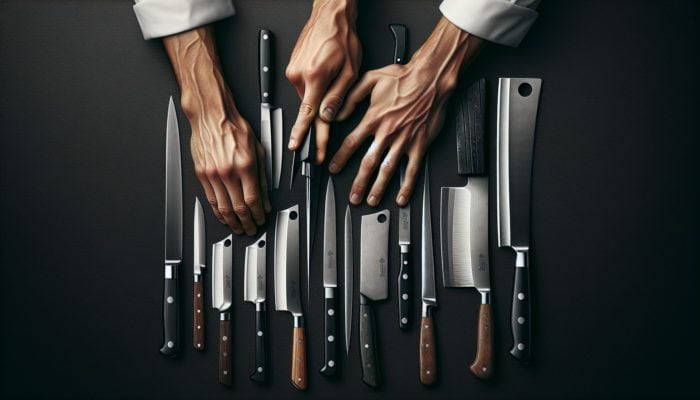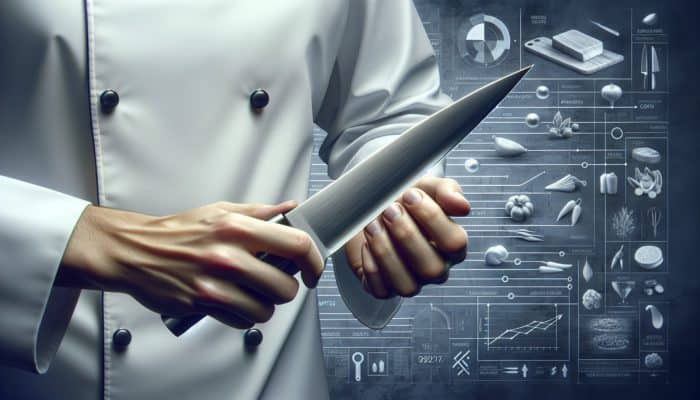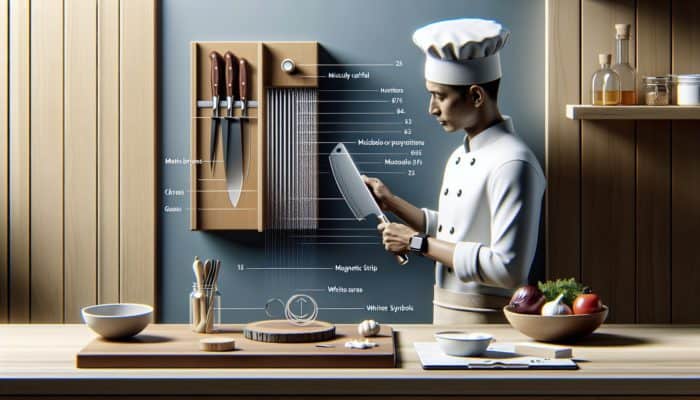Elevate Your Culinary Expertise with Expert Knife Sharpening Techniques
Understanding the Vital Role of Knife Angles for Precision Sharpening

Grasping the significance of knife angles is essential for attaining the highest level of sharpness when sharpening your blades. Various knife types, such as the precise yanagiba favoured by sushi chefs and the robust butcher’s cleaver, are designed with unique sharpening angles tailored for specific culinary tasks. In general, most kitchen knives should be sharpened at angles between 15 to 20 degrees. However, there are exceptions depending on the knife’s construction and intended purpose. For example, Japanese knives typically require sharper angles to enhance their precision, a factor that demands a higher skill level for maintenance and care.
To ascertain the ideal sharpening angle, you can either use a protractor or rely on visual judgement to align the blade with your sharpening tool. Adjust until you achieve the desired angle. Remember, a sharper angle yields a finer edge suitable for delicate tasks, while a broader angle produces a sturdier edge ideal for more demanding cutting applications. By understanding these nuances, you can significantly elevate your sharpening skills, ensuring your knife performs at its best for its specific culinary tasks.
Selecting the Perfect Sharpening Tool for Your Knife Collection
Choosing the appropriate sharpening tool is crucial for maintaining a razor-sharp edge on your knives. There is a vast array of options available, including whetstones, sharpening rods, and electric sharpeners, each designed for specific sharpening techniques and personal preferences. Whetstones are often the preferred choice among enthusiasts due to their versatility and precision, allowing meticulous control over both the sharpening angle and the pressure exerted. As you become more adept with these stones, you will appreciate the tactile feedback that makes the sharpening process a rewarding and instinctive experience.
In contrast, sharpening rods offer a quick solution for touch-ups, particularly in busy kitchen environments where efficiency is paramount. With a few swift strokes, you can realign the knife’s edge, instantly restoring its functionality. While electric sharpeners may not be traditional, they provide considerable convenience and consistent results, making them a practical choice for those lacking confidence in manual sharpening techniques. Ultimately, your choice of sharpening tool will depend on your personal preference, skill level, and the specific requirements of your knife collection.
Why Consistent Pressure is Key to Effective Knife Sharpening
Maintaining consistent pressure is essential for achieving a uniform edge while sharpening your knife. Inconsistent pressure can lead to uneven sharpening, resulting in a blade that underperforms. As you begin the sharpening process, focus on applying steady, even pressure while moving the blade against the sharpening tool. This technique not only produces a smoother edge but also helps to prevent excessive wear on one side of the blade. Many seasoned sharpeners recommend honing your pressure technique on a less expensive knife to build confidence before advancing to more valuable tools.
Additionally, be mindful of your grip and the knife’s angle during sharpening. A secure grip combined with consistent pressure will enhance the sharpening experience, allowing the blade to maintain its structural integrity. As you refine your technique, you may notice that slight adjustments in pressure can yield different results, enabling you to customise the sharpness to your preferences. With regular practice, this skill will become second nature over time.
Essential Strategies for Maintaining Your Knife’s Sharp Edge

Regularly honing your knife, alongside implementing proper storage techniques, is paramount for sustaining its sharpness and can greatly extend the intervals between major sharpening sessions. Honing serves to realign the knife’s edge and should ideally be performed before each use. This routine maintenance not only enhances your knife’s performance but also diminishes the need for extensive sharpening. Investing in a quality honing rod can simplify this process, ensuring your knives remain in optimal condition for all your culinary tasks.
Equally critical is the manner in which you store your knives. Storing them loosely in a drawer can lead to dull blades and potential damage. Instead, consider utilising a magnetic strip, knife block, or protective blade guards to safeguard the edges while promoting safety. By adhering to a consistent routine of regular honing and appropriate knife storage, you can save both time and money, significantly enhancing your culinary experience in the kitchen.
Expert Insights on Best Knife Sharpening Practices from Professionals
Knife Sharpening Techniques Employed by Renowned Chefs Worldwide
Chefs around the globe employ a diverse range of techniques to keep their knives in peak condition, ensuring optimal performance. A common method is the combination of whetstones and honing rods. Chefs typically start with a coarse whetstone to reshape the knife’s edge, followed by finer stones to achieve a polished finish. This layered approach allows them to achieve an incredibly sharp edge that meets the demanding requirements of high-volume kitchens, where both precision and speed are crucial.
For instance, renowned chefs in Japan often emphasise the importance of traditional knife sharpening methods, frequently curating a collection of whetstones specifically tailored for various knife types and sharpening needs. They not only invest in high-quality knives but also dedicate time to honing their sharpening skills, recognising that a sharp knife is essential for maintaining the quality of their culinary creations. Additionally, many chefs form a personal connection with their knives, using them for years, making regular maintenance a vital component of their culinary identity.
Best Practices for Long-lasting Knife Maintenance

Proper knife maintenance is vital for ensuring their longevity and effectiveness in the kitchen. Below are essential tips to keep your knives in excellent condition:
- Hone regularly: Utilise a honing rod before each use to realign the blade.
- Hand wash: Avoid the dishwasher; hand wash with a mild detergent to prevent damage.
- Dry immediately: Wipe your knives dry after washing to prevent rust and discolouration.
- Store properly: Use a knife block, magnetic strip, or blade guards to protect edges.
- Sharpen as necessary: Avoid over-sharpening; establish a schedule based on your knife’s usage.
- Keep them clean: Regularly remove any food particles or residue that can dull the blade.
- Inspect regularly: Check blades for chips or dullness and address issues promptly.
By following these best practices, you can significantly extend the lifespan of your knives while maintaining their cutting efficiency. Many chefs assert that dedicating just a few minutes each week to caring for their knives greatly enhances their overall culinary experience.
Effective Methods for Testing Your Knife’s Sharpness
Testing your knives for sharpness is a straightforward yet essential task that ensures your sharpening efforts yield the desired results. One effective method is the paper test, which involves slicing through a piece of paper. A truly sharp knife will cut cleanly and effortlessly, without snagging or tearing the paper. Another popular method among chefs is the tomato test; a sharp knife should slice effortlessly through the skin of a ripe tomato.
To perform the paper test, hold the paper upright and attempt to slice through it with your knife. If the blade glides through smoothly, congratulations—you’ve successfully sharpened your knife! If it struggles or tears the paper, further sharpening is needed. For the tomato test, apply gentle pressure to the skin; a sharp blade should penetrate easily without excessive force. These simple tests provide immediate feedback on the effectiveness of your sharpening technique and help you calibrate future sharpening efforts.
Avoiding Common Pitfalls in Knife Sharpening
Strategies to Prevent Over-sharpening Your Blades
Over-sharpening is a frequent mistake among knife owners, which can seriously diminish the lifespan of their blades. Each sharpening session removes tiny amounts of metal from the edge. If you sharpen too often, particularly when unnecessary, you risk rapidly degrading the blade. To prevent this, develop an understanding of how frequently your knives should be sharpened based on their usage and wear.
Casual home cooks may find they need to sharpen their knives only a few times a year, while professional chefs might require more frequent sharpenings. However, it is crucial to regularly assess sharpness and resist the urge to sharpen after every use. Instead, focus on honing your knives consistently, which helps realign the edge without removing any metal. This practice will help prevent excessive wear and ensure your knife remains effective for your culinary needs.
Avoiding the Use of Incorrect Grit for Sharpening
Another common error is starting with the wrong grit when sharpening. Many novice sharpeners mistakenly select a fine grit stone, hoping for quick results. However, starting with too fine a grit can lead to ineffective sharpening, as it may not adequately reshape a dull edge. Instead, begin with a coarse grit to address any nicks or dullness. Once the edge has been reshaped, gradually transition to finer grits for finishing touches.
The progression from coarse to fine should feel seamless as you navigate through the grits to achieve a polished finish. Each grit serves a specific function in the sharpening process, helping to create the ideal edge suited for your particular knife type. Understanding the purpose of each grit will enhance your sharpening results, allowing you to keep your knives in peak condition for a longer period.
The Critical Importance of Blade Alignment for Effective Sharpening
Neglecting blade alignment can severely hinder the sharpening process and reduce your knife’s overall effectiveness. A misaligned edge complicates sharpening and can lead to uneven wear and potential damage over time. To mitigate this issue, it’s essential to consistently incorporate a honing rod into your routine. This simple tool realigns the edge and prepares it for sharpening, ensuring that your knife retains its structural integrity.
Regular honing not only keeps your blades aligned but also decreases the frequency of major sharpening sessions. Many proficient chefs advocate honing their knives before each use, integrating it seamlessly into their kitchen preparation. By prioritising alignment, you’ll find that sharpening becomes less of a chore and more of a quick tune-up for your essential tools.
Best Techniques for Sharpening Various Types of Knives
Specialised Approaches for Sharpening Serrated Knives
Serrated knives necessitate unique sharpening techniques due to their distinctive design. The scalloped edges can render traditional sharpening methods ineffective. Instead, using a tapered sharpening rod is the optimal approach to maintain the serrations while ensuring the knife remains functional. These rods fit perfectly into the grooves of the serrated edge, enabling targeted sharpening without damaging the blade.
To effectively sharpen a serrated knife, ensure you are using a rod that matches the size and shape of the serrations. Start by inserting the rod into one of the serrations, applying gentle pressure as you slide it back and forth. Repeat this for each serration, taking care to avoid overlapping the blade’s edge. This technique helps preserve the integrity of the serrated knife while ensuring a sharp cutting surface that performs optimally.
Optimal Method for Sharpening a Chef’s Knife
A chef’s knife is one of the most versatile tools in any kitchen, and it benefits greatly from regular sharpening. The best method for sharpening a chef’s knife is to use a whetstone, which offers excellent control throughout the sharpening process. Begin by soaking the whetstone in water for about 10 to 15 minutes, allowing it to absorb moisture, which reduces friction and results in a smoother sharpening experience.
Once the stone is properly prepared, position your knife at the desired angle—typically around 20 degrees for a chef’s knife—and draw the blade across the stone. Start at the heel and move toward the tip, applying consistent pressure throughout the stroke. It’s essential to maintain a steady angle and pressure during the sharpening process. After several passes on one side, flip the knife and repeat on the opposite side. Finally, finish with several strokes on a finer grit to polish the edge and enhance its sharpness.
Maintaining the Edge on Pocket Knives Effectively
Pocket knives are often used for a variety of tasks, from opening packages to food preparation, and they require consistent maintenance to keep their edges sharp. One of the best practices is to carry a small sharpening stone for touch-ups on the go. A compact whetstone or a pocket-sized ceramic rod can be invaluable for maintaining an edge whenever necessary.
When sharpening your pocket knife, adhere to the same principles as with larger knives. First, ensure the knife is clean and free from debris. Then, select an appropriate angle—typically around 20 degrees—and apply consistent pressure as you slide the blade across the stone or rod. Regular sharpening of your pocket knife not only enhances its cutting efficiency but also ensures it’s ready for action at any moment.
Research-Backed Benefits of Effective Knife Sharpening Techniques
Enhancing Cutting Efficiency with Well-Sharpened Knives
A sharp knife is a joy to use; it cuts more efficiently, significantly reducing the effort required to slice through various foods. This efficiency translates into less time spent on ingredient preparation, resulting in a more enjoyable cooking experience overall. The effort needed to slice through vegetables diminishes, facilitating smoother, cleaner cuts that enhance both texture and presentation.
To achieve the sharpest edge, focus on refining your sharpening technique. Use the correct angle and pressure, and don’t hesitate to start with a coarse grit if necessary to reshape the edge. A finely honed edge can dramatically improve cutting performance, impressing both home cooks and professional chefs alike.
The Safety Benefits of Using Sharp Knives in Your Kitchen
Surprisingly, sharp knives are safer than their dull counterparts. Dull knives require greater force to cut, increasing the risk of slips and accidents. Conversely, using a sharp knife allows for smooth slicing through ingredients with minimal pressure, granting you greater control and precision. This reduction in force leads to fewer accidents, thereby creating a safer kitchen environment.
Incorporating knife sharpening into your regular kitchen routine not only enhances safety but also boosts your confidence in your cooking abilities. Knowing you are equipped with well-maintained tools can transform your culinary experience, allowing you to focus on creativity rather than struggling with ineffective equipment.
Long-Term Advantages of Consistent Knife Sharpening
Regular sharpening extends the lifespan of your knives, ensuring they remain reliable tools for years to come. By maintaining a robust sharpening routine, you decrease the likelihood of significant damage that would necessitate professional repair or replacement. Knives that are routinely sharpened maintain their performance, making them invaluable assets in any kitchen.
Furthermore, consistent maintenance fosters a deeper appreciation for your tools. As you dedicate time to keeping them sharp, you cultivate a more personal connection to your knives, recognising the craftsmanship and care involved in their use. This relationship ultimately enhances your cooking experience, resulting in greater satisfaction during meal preparation.
Improving Food Presentation Quality with Sharp Knives
A sharp knife enables precise cuts, significantly enhancing the visual appeal of your dishes. Whether you’re julienning vegetables or slicing fresh herbs, clean edges create a polished look that elevates your presentations. Sharp knives allow you to achieve professional-quality results, transforming home-cooked meals into restaurant-worthy dishes.
To master the art of presentation, focus on techniques such as angle control and consistent pressure while cutting. These skills will not only enhance the aesthetic quality of your dishes but also contribute to the overall dining experience. Your attention to detail will shine through in the meals you prepare, impressing your family and friends alike.
Reducing Food Waste by Maintaining Sharp Edges
Keeping your knives sharp minimises the chances of crushing or tearing food, allowing you to preserve more usable portions. When knives are sharp, they can slice through ingredients cleanly, reducing waste during preparation. This efficiency translates into cost savings and promotes a more sustainable approach to cooking.
For instance, when preparing fruits or vegetables, a sharp knife ensures you achieve clean cuts without damaging the flesh, maximising the yield from each item. By consistently sharpening your knives, you not only enhance your cooking experience but also contribute to reducing food waste in your kitchen.
Essential Tools and Accessories for Successful Knife Sharpening
Choosing the Right Whetstone for Your Knives
Whetstones come in various grits, each tailored for different stages of the sharpening process. Selecting the correct stone is vital for achieving your desired results. Coarse grit stones (typically 200-600 grit) are perfect for reshaping or repairing damaged edges, while medium grit stones (800-2000 grit) excellently refine the edge. Finally, fine grit stones (3000 grit and above) are ideal for polishing and achieving a razor-sharp finish.
When choosing a whetstone, consider the types of knives you will be sharpening and their specific requirements. For most home cooks, a combination stone featuring both coarse and fine sides can be an excellent choice, providing versatility without overcrowding your kitchen. As your sharpening skills advance, you might opt to invest in individual stones tailored to your specific knife types.
Understanding the Importance of Honing Rods for Knife Maintenance
Utilising honing rods is crucial for maintaining the edge between sharpening sessions. These tools are designed to realign the blade’s edge, keeping it straight and effective. Regular use of a honing rod can significantly reduce the need for extensive sharpening, making it an indispensable asset in any kitchen. By consistently honing your knives, you can keep them in peak condition without removing excessive material from the blade.
To use a honing rod, hold it vertically and glide the blade down its length at the proper angle. Repeat this process several times on each side, ensuring you maintain even pressure throughout. The more you incorporate honing into your routine, the longer your knives will retain their sharpness, making your culinary tasks smoother and more enjoyable.
The Benefits of Using an Electric Sharpener
Electric sharpeners offer convenience and consistent results, particularly for individuals who may lack the time or skill to sharpen manually. These devices are designed to provide precise angles and uniform pressure, making them user-friendly for beginners. Here are some key advantages of using an electric sharpener:
- Speed: Electric sharpeners can quickly sharpen knives in just minutes.
- Consistency: They maintain the correct angle for optimal results every single time.
- Ease of use: Many models are straightforward, requiring minimal technique or experience.
- Variety: Some models accommodate various knife types, including serrated blades.
- Minimal effort: Electric sharpeners demand little physical exertion, making them suitable for all skill levels.
Incorporating an electric sharpener into your knife maintenance routine can enhance convenience while ensuring your knives stay sharp and ready for action at all times.
Common Questions about Knife Sharpening Addressed
How often should I sharpen my knives?
The frequency of sharpening varies based on usage; home cooks may sharpen a few times per year, while professionals might require more frequent sharpening. Regularly honing your knives is essential to maintain the edge between sharpening sessions.
Can I use a whetstone on any type of knife?
Yes, whetstones are suitable for most types of knives, including chef’s knives, paring knives, and even certain serrated knives, given the correct technique.
What’s the distinction between honing and sharpening?
Honing realigns the edge of a knife to maintain sharpness, whereas sharpening removes material to create a new edge. Both processes are vital for comprehensive knife maintenance.
How do I know when my knife needs sharpening?
If your knife struggles to cut through food or feels dull during use, it’s time to sharpen it. The paper or tomato test can help assess sharpness effectively.
Is it safe to sharpen knives at home?
Yes, sharpening knives at home is safe when performed correctly. Ensure you follow proper techniques and utilise reliable sharpening tools to minimise risks.
What type of whetstone should I buy as a beginner?
A combination whetstone featuring both coarse and fine grits is ideal for beginners, offering versatility for different sharpening needs without overwhelming complexity.
Can I use an electric sharpener for serrated knives?
Some electric sharpeners are designed to accommodate serrated knives; however, check the specifications to ensure compatibility. Manual sharpening methods are often preferred for serrated blades.
How can I extend the life of my knives?
Regular honing, proper storage, hand washing, and avoiding excessive sharpening will all contribute to the longevity of your knives.
What’s the best way to store my knives?
Store knives in a knife block, on a magnetic strip, or with blade guards to protect edges and ensure safety in the kitchen.
Do professional chefs sharpen their knives differently?
Yes, many professional chefs utilise whetstones in conjunction with honing rods, focusing on maintaining sharp edges to meet the demands of their busy kitchens.
Explore our world on X!
The post Knife Sharpening Tips: Master the Art of Edge appeared first on Survival Bite.
The Article Knife Sharpening Tips: Perfect Your Edge Skills Today Was Found On https://limitsofstrategy.com



